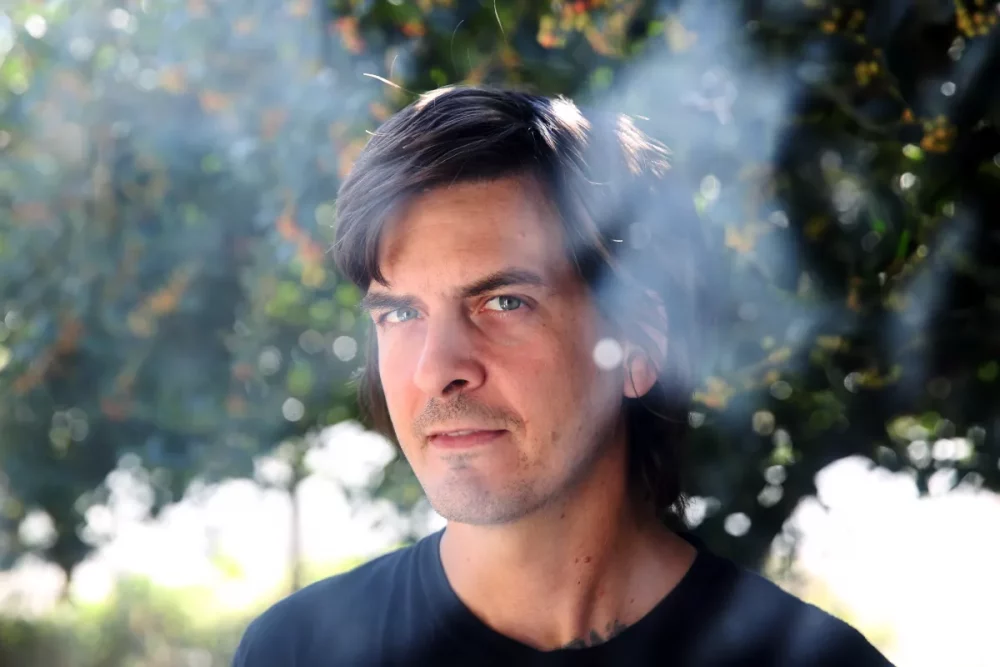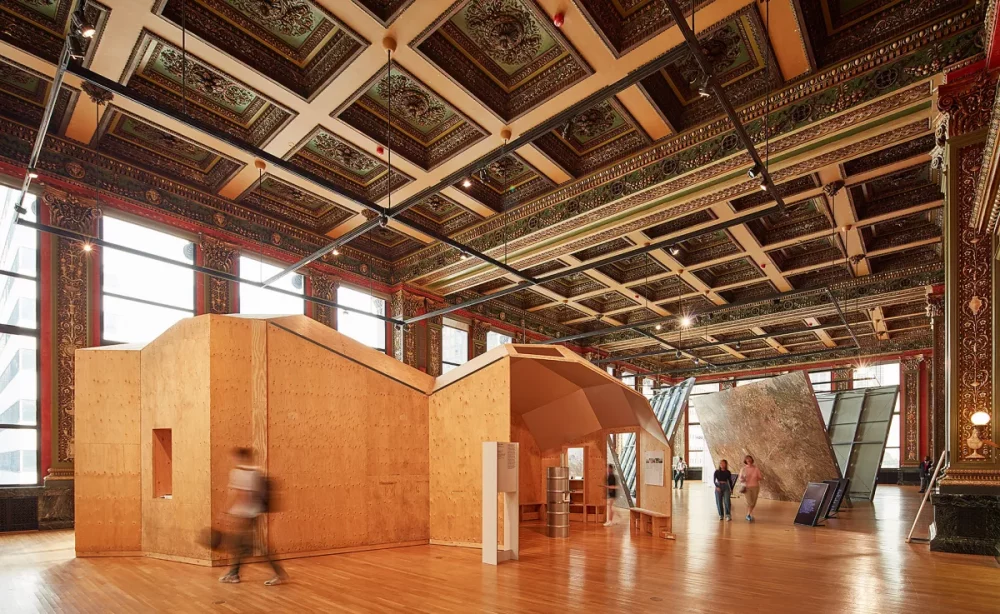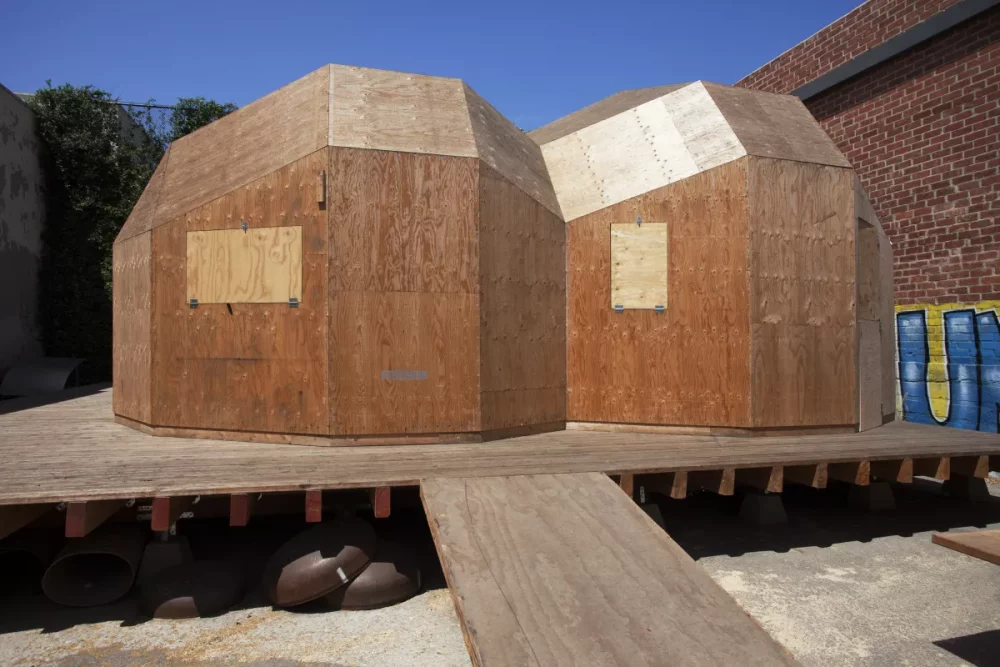
- Source: LOS ANGELES TIMES
- Author: CAROLINA A. MIRANDA
- Date: NOVEMBER 21, 2019
- Format: ONLINE
Oscar Tuazon’s water and ‘hippie outlaw architecture’ obsessions began with a dome

Oscar Tuazon has an installation on view at the Chicago Architecture Biennial that is inspired by zome architecture from the 1970s.(Dania Maxwell / Los Angeles Times)
Chicago — Los Angeles artist Oscar Tuazon will not forget the day he called up inventor and builder Steve Baer to talk about domes.
It was about 15 years ago and Tuazon had become intrigued by a 1971 dome construction manual called “Domebook 2.” Written by author and builder Lloyd Kahn, who’d served as shelter editor for the counterculture bible Whole Earth Catalog in the 1960s, the book awakened a latent interest in dome architecture for Tuazon, who comes from a family of dome builders in Washington state. Further research led him to Baer, who was famous for building a dome-inspired house outside of Corrales, N.M., known as the Zome Home.
“He tried to warn me off it,” says Tuazon. “He was like, ‘It’ll ruin your life.’ But here I am.”
“There are a lot of reasons domes have not become a typology,” he says with a laugh. “But some of us never learn.”
For years after the call with Baer, Tuazon kicked around ideas inspired by the zome compound that Baer built for himself in the high desert. The zome’s unique form was inspired by a fusion of the dome and the zonohedron, a type of complex polyhedron (basically, a dome that has been bent and stretched so that it has vertical walls and a nonspherical shape). Baer took that form and made a home that is solar efficient — insulated by drums of water that are warmed by the sun during the day and keep the structure warm at night.
“It’s just beautiful,” says Tuazon. “It’s thermal performance; it’s cozy during the winter and airy during the summer. It’s a great piece of architecture.”

An installation view of Oscar Tuazon’s “Great Lakes Water School” at the third Chicago Architecture Biennial.”(Tom Harris / Chicago Architecture Biennial)
Over the last three years, that architecture has materialized repeatedly in Tuazon’s work, with zome-inspired prototypes built by the artist and various collaborators appearing in exhibitions in Switzerland, Michigan and Southern California — and, currently, at the Chicago Architecture Biennial in Illinois, on view through Jan. 5.
The sculptor’s building spree began in earnest in 2016, thanks to a commission from Art Basel in Switzerland, when he realized a full-size model of Baer’s Zome Home, a piece titled “Zome Alloy,” that dominated the Messeplatz area during that year’s art fair. Two years later, he completed a cluster of three zome modules around a water tank in the courtyard of his L.A. studio, an old warehouse space that sat within several hundred feet of the Los Angeles River.
Baer’s design inspired Tuazon to give his zome a thematic focus: water.
“One of the things that is beautiful about the original structure is the water-filled barrels,” Tuazon says. “We’ve taken the barrels and flattened them down and retained the idea of using water as a thermal mass. But by flattening them, now you can literally see through the water. It’s like a double-paned glass. It becomes the lens through which we see the landscape. It’s that literal and direct.”
Tuazon dubbed his L.A. structure the “Los Angeles Water School (LAWS)” and, for more than a year, used it as a gathering space to discuss issues related to water — but in ways that took the conversation beyond the notion of water as resource.
“It was important for us to do programming that was connected to the indigenous history and Yaanga,” he says, referring to the Tongva settlement that preceded Los Angeles. “It started with Tongva elders who we invited and we were very quickly talking about water issues: Where does the L.A. River connect us to? How does L.A.’s water connect to the Sierra Nevada? And the Colorado River? And dispersed hydrological landscapes?”
Another zome experiment went on view in Michigan earlier this year, a state plagued by water troubles in Flint. In “Great Lakes Water School,” his most recent iteration of the project on display at the Chicago Architecture Biennial, Tuazon harkens to what he describes as the “hippie outlaw architecture” of the 1960s — albeit updated for the present day.
Yesomi Umolu, artistic director of the biennial, says the project takes “questions around advocacy in relation to clean water and tries to connect it demographically around the U.S. … It also revisits this moment of DIY architecture, of questions of environment and sustainability, and how do you bring it into the future and create a space of learning and pedagogy.”
Certainly, it’s a type of architecture whose history is complex.
Some of the DIY architectural communities of the 1960s represented a unique form of white flight, says Tuazon, “this suburban disengagement of urban problems.” But he says that their underlying ideas about self-sufficiency and energy efficiency remain relevant in a time of climate crisis.
“I always felt like it was an unfinished project — a lot of that hippie architecture,” he says. “A lot of the ideas are still valid.”

Oscar Tuazon’s “Los Angeles Water School” in his studio’s courtyard in 2018.(Jeremy Jansen)
This summer, “Los Angeles Water School” traveled to Nevada, where Tuazon ultimately hopes to install it on a plot of land that he has acquired in the high desert. It consists of 40 undeveloped acres containing a small lake near Goshute indigenous territory on the Utah-Nevada border — a place where the Southern Nevada Water Authority wants to lay down a pipeline to feed the appetite for resplendent fountains in Las Vegas. (The theme of pipelines is a concept that Tuazon has also explored, including in an installation at the Hammer Museum in 2016.)
His hope is that the Great Lakes zome might also end up there, employed as a learning center, but also functioning as a symbol of careful stewardship.
“Ideas and conversations around water rights and indigenous histories is also this really powerful part of the story,” he says. “And it shapes the way the design is evolving now — to take this structure and break it into its constituent parts and think about how it could work in different landscapes. It’s trying to kind of absorb and learn from those places.”
Fifteen years after dialing up Baer, Tuazon isn’t finished with domes.

